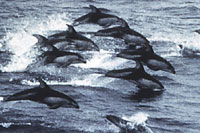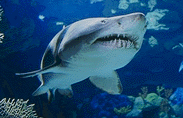|
保護海豚,導致其他魚類受到嚴重威脅?
作者:Rick Gaffney 10.28.99
當美國商業貿易部在四月份宣佈改變鮪魚罐頭上「保育海豚」的標籤標準時,遭到保護這些有靈性的大型動物的人士嚴重抗議。雖然新的法規仍然規定不得殺害、或是嚴重傷害任何海豚,但是美國商業貿易部允許鮪魚罐頭商人使用「保護海豚」作為標籤?即使他們使用大型圍網來捕捉鮪魚,而這些魚網依舊會誘捕到海豚。

嬉戲中的有魅力大型動物。照片由NOAA提供
環保團體對這新法規有兩派不同的意見。綠色和平組織、海洋保育中心,以及其他團體,力主應該讓國際漁業團體加入保育的行列,讓他們主動提出更有力的保護海豚方案。另外一派團體,包括了野生動物保護協會、地球村協會等,在八月時提出訴訟,抵制美國商業貿易部,試圖推翻這些新法規。
然而,這個故事的另一面,發生在熱帶的東太平洋。遵循舊法規的捕鮪魚方法,導致超過數百萬磅、非對象魚類遭殺害,包括馬林魚(旗魚)、棘鰆、鯊魚、及其他大洋性魚類,且持續地捕捉未成熟繁殖的鮪魚。我們趕著去「救海豚」的同時,卻極可能造成其他的環境破壞。關於這些深遠的影響,絕大部分都不為人們所了解。
尋找血腥兇手
這起因於1980年代後期,海豚在巴拿馬鮪魚雙船圍網裡溺死的影像,在國際電視頻道播出。數千隻海豚隨著鮪魚魚群被包圍起來,當網子在海面下收攏時,大部分需要空氣的哺乳類被溺死。海豚掙扎地死於窒息和其他一大群魚在小網孔的魚網當中被捕獲,這個恐怖的景象,只有最無情的人不會動心。
在熱帶東太平洋,往往可以在海豚下方,發現成熟的黃鰭鮪魚群。於是鮪魚圍網船以海水表面的海豚作為指引來下網,導致許多海豚陷入網中。

尚未成為罐頭的黃鰭鮪魚。照片由NOAA提供
美國鮪魚業者本身早已著手避免數千隻海豚的死亡。他們改善裝備、發展特殊的操作方法與技術,並以人工幫助陷入網內的海豚逃脫。
不過,溺死的海豚的影帶,仍然導致最有效的基金籌募、以及法案的通過,成為近代史上最有力的環保行動。這股要求任何海豚不得遭到殺害的壓力,成功地導致美國每一個鮪魚罐頭標上「保育海豚」的標籤。
抱歉了,查理 (有一好、無二好)
自從反對海豚死亡的事件發生後,在熱帶東太平洋的捕捉鮪魚的圍網船,跨過海洋到另一個新的地帶,並使用另一種技術,稱為流木法。圍網船將網子掛在數個浮起的物體上(通常都稱為「流木」。但所有的浮起物均符合此目的,包括圍網船故意投放的漂浮物)。不只鮪魚聚集在浮木下,尚包括其他種類的魚。但是,捕捉位置和技術的改變,似乎對鮪魚群帶來了噩耗。
在熱帶東太平洋,捕捉的對象主要為成熟的、已生殖過數次的鮪魚。夏威夷Pelagi大學水產研究課程的水產生物學家David Itano指出,這些地區使用的大型圍網法,所造成的誤捕少。

鯊魚,意外的收穫?
根據水產生物學家Bill Boyce,他早期是美國國家海洋魚類鮪魚大型圍網的觀察家。他指出自從1990年初「海豚保護」法案發展出來後,以流木法捕獲1000噸的鮪魚時,連帶的有 200-400噸的黃鰭鮪以及正鰹的幼魚被殺害、丟棄。他說: "這些魚甚至尚未開始生育呢!"
Itano指出,因依流木而棲的族群種類涵蓋廣,流木法比任何圍網漁法的誤捕率高。Boyce說: 「大致上,使用新捕魚法的船每航次,都會導致1,500尾鯊魚、2000至5000尾鬼頭刀、2000至3000尾棘鰆、50至100尾旗魚、200至300尾雨傘旗魚,加上雙帶魚參、板機魨、幼小的魚參,以及松鯛的丟棄與死亡」。
所以鮪魚業者從用老方法的每收穫1000噸成熟黃鰭鮪讓10至30隻海豚冤死的做法,改變為造成海洋生態破壞更深遠影響的新方法。這將許多保育人士原本淺白的爭論?我們必須停止殺害海豚?變得更加複雜。
是誰吃了你?
遺憾的是,我們並未擁有充足的生物知識,來將這些破壞量化。但是,很明顯的,捕捉數百萬隻未成年、未生育的鮪魚、以及其他魚類,長期下來,將對太平洋的遠洋生態環境有很大的衝擊。

在深藍色海洋中的海豚。照片由OAR/NURP提供
一個較有效的解決方法,就是成立一個全太平洋的遠洋魚類管理機構,並支持廣泛的生物學研究,來探討捕捉鮪魚對太平洋的衝擊。目前有許多科學家想要參與制定法規,也有其他由政府主持的會議想要徵詢科學家的建議。大家對區域發展管理的興趣似乎提高了;不過,整合需要一段時間。因為各國政府所關心的議題不同,要調和這麼多的組織與多方的參與者並不容易。
海洋種苗放流法,是將魚卵經由人工孵化後,釋放到海洋中使其生長,再行捕捉。這可能可以滿足鮪魚的市場需求。
無論從哪一方面來看,目前只為保護熱帶東太平洋的海豚不被殺害的措施,對環境而言並不是最好的選擇。
也許,最簡單的方法,就是少吃點鮪魚。
Rick Gaffney,為一位得獎的自由冒險攝影家,居住在夏威夷,專長於海洋環境、以及海洋休閒。
原文與圖片詳見 : http://www.gristmagazine.com/grist/
mainevent/gaffney102899.stm
版權歸屬Earth Day Network,環境信託協會 (黃曉菊 譯,陳維立審校) |
|
Are efforts to protect the dolphin putting other fish in a sea of trouble?
by Rick Gaffney
10.28.99
There were predictable cries of protest from some conservationists who focus on charismatic megafauna when revised standards for use of the "dolphin safe" tuna label were announced by the Commerce Department in April. Though the new rules stipulate that no dolphins should be killed or seriously injured, they do let canners label their product "dolphin safe" even if tuna are caught using large, encircling nets that can snare dolphins.
Charismatic megafauna at play. Photo courtesy of NOAA.
The environmental community is split on the revised rules. Greenpeace and the Center for Marine Conservation, among other organizations, say the changes are needed to get the international fishing community on board with stronger dolphin protections. A separate coalition of groups, including Defenders of Wildlife and the Earth Island Institute, filed suit against the Commerce Department in August, seeking to overturn the new rules.
Yet another side of the story is that protection of dolphins in the Eastern Tropical Pacific Ocean under the old "dolphin safe" rules resulted in the slaughter of millions upon millions of pounds of unwanted marlin, wahoo, sharks, and other species of pelagic fish, as well as the sustained harvest of immature, not-yet-spawned tuna. Our rush to "save the dolphin" may well have created devastating environmental impacts, which are still largely unrecognized.
Screening Bloody Murder
It all began in the late 1980s, when graphic videos of dolphins being drowned in Panamanian tuna purse seine nets were aired on international television. Thousands of porpoises were being rounded up, along with the schools of tuna sought by the seiners, and many of the air-breathing mammals were drowned as nets were "pursed," smothering the animals in a mass of fish and net mesh. It was a nightmarish scene, one that pulled at the heartstrings of all but the most stoic.
Schools of mature yellowfin tuna in the Eastern Tropical Pacific are often found swimming beneath dolphins, and tuna seiners were using surface dolphin activity as a guide to set their nets, trapping many dolphins as a result.
Yellowfin tuna, uncanned. Photo courtesy of NOAA.
The American tuna industry had begun making efforts on its own to curb the thousands of dolphin deaths, by improving its equipment, developing specialized maneuvering and recovery techniques, and physically helping dolphins escape from nets.
Still, the graphic videotape of drowning dolphins led to one of the most effective fund-raising and lobbying efforts in the recent history of environmental activism. The pressure was on to stop the killing of any dolphin, leading to the ultimately successful campaign to make every can of tuna in the U.S. "dolphin safe."
Sorry, Charlie
After the outcry over dolphin deaths, tuna seiners who had worked in the Eastern Tropical Pacific crossed the ocean to new grounds and began using a different technique called log fishing. The seiners set their nets on various floating objects (generally referred to as "logs," although any floating objects serve the purpose, including those set out by seiners themselves). Tuna congregate under the logs, as do many other species. But this shift of location and technique seems to have been bad news for tuna populations.
In the Eastern Tropical Pacific, the tuna catch had primarily consisted of mature adults which would presumably have spawned several times before they were harvested. The encirclement method used in this region also produced very little by-catch, according to David Itano, a fishery biologist with the University of Hawaii's Pelagic Fisheries Research Program.
The shark -- a casualty of casserole?
But under the "dolphin safe" rules developed in the early 1990s, a typical haul of 1,000 tons of tuna caught primarily by the log method results in the killing and dumping of 200 to 400 tons of small, immature yellowfin and skipjack tuna, according to fisheries biologist Bill Boyce, a former tuna purse seine fishery observer for the National Marine Fisheries Service. "These fish haven't even spawned yet!" he says.
Also, log fishing, because of the diverse community associated with the floating object, has the highest by-catch levels of any seining method, reports Itano. "Generally, 1,500 sharks, 2,000 to 5,000 dorado, 2,000 to 3,000 wahoo, 50 to 100 marlin, 200 to 300 sailfish, plus rainbow runners, triggerfish, small jacks, and tripletail are dumped, dead, on every trip these boats now make," says Boyce.
So the tuna fishery was transformed from one that might have resulted in the deaths of 10 to 30 dolphins for a 1,000-ton load of mature yellowfin tuna to one that may be far more destructive ecologically. An issue that had seemed straightforward to many activists -- we should stop killing dolphins, of course -- turned out to be far more complex.
What's Eating You?
Sadly, we do not have adequate biological knowledge to quantify the full extent of the destruction, but it is clear that the capture of millions of tuna too young to have spawned and the killing of many other species that are critical to the pelagic ecosystem cannot be good for the Pacific's environment over the long run.
Dolphins in the deep blue sea. Photo courtesy of OAR/NURP
One approach to the problem might be to convene a single, Pacific-wide, pelagic fishery management authority, and to support widespread biological investigations into the impact of tuna fishing in the Pacific. Currently there are various meetings of scientists with political overtones, and there are separate political meetings of governments with scientific input. Interest in broader regional management seems to be mounting, but it could take a while to come together because of the varying concerns of individual governments and the difficulty of meshing large organizations with other players.
Ocean ranching -- in which fish are produced in hatcheries, released to feed at sea, and later harvested -- could also help supply tuna to a demanding market.
In any case, it seems clear that simply barring the slaughter of Eastern Tropical Pacific dolphins is not the best alternative for the environment.
Perhaps the simplest remedy would be to eat less tuna.
Rick Gaffney is an award-winning freelance photojournalist who lives in Hawaii and specializes in the marine environment and ocean recreation |
